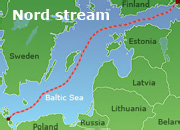“We have completed this most challenging part of the pipeline through the Baltic Sea on schedule and have now laid over 80 percent of line 1 of the twin pipeline,” says Nord Stream Deputy Director of Construction Ruurd Hoekstra. “Together with our main contractor Saipem we chose Allseas’ dynamically-positioned pipelay vessel Solitaire to lay part of this section because it operates without anchors, so that only the pipeline itself touches the seabed along the precise route agreed with the Finnish authorities. This has been an added safety guarantee for us in this congested area of the Baltic Sea known for its historic mine lines. I am pleased to say that everything has gone according to plan,” he added.
“The smooth running of our construction programme has been made possible by the meticulous planning of every aspect – technical, logistic, safety, environmental and operational – of this complex infrastructure project, which we developed in consultation with the authorities of all five countries through whose waters the pipeline will pass,” Mr Hoekstra added.
The connection of the three major pipeline sections will be carried out at the two offshore locations where the design pressure changes: from 220 to 200 bar and from 200 to 170 bar respectively. The Gulf of Finland and central sections will be connected off the coast of Finland in spring at a sea depth of approximately 80 metres. The connection of the central and south-western sections off the coast of Gotland, Sweden, to take place in summer at a depth of approximately 110 metres, will mark the completion of construction of line 1.
23 Декабря 2025 | вторник | 07:40


